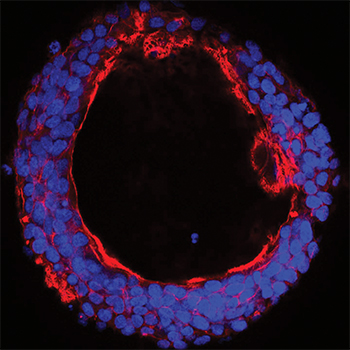JBC: A sugar-attaching enzyme defines colon cancer
Researchers have identified an enzyme that is absent in healthy colon tissue but abundant in colon cancer cells, according to published in the Journal of Biological Chemistry.
 The enzyme GalNAc-T6 is upregulated selectively in colon adenocarcinomas, and its expression is associated with a cancerlike growth pattern.courtesy of Kirstine Lavrsen/University of Copenhagen
The enzyme GalNAc-T6 is upregulated selectively in colon adenocarcinomas, and its expression is associated with a cancerlike growth pattern.courtesy of Kirstine Lavrsen/University of Copenhagen
The enzyme appears to drive the conversion of normal colon tissue into cancer by attaching sugar molecules, or glycans, to certain proteins in the cell. Understanding the role that sugar-modified proteins play in healthy and cancerous cells is an emerging area of cancer biology that may lead to new therapies.
team at the studied 20 enzymes that initiate the first step in a particular kind of glycan modification, called GalNAc-type O-glycosylation, found on diverse proteins. These enzymes, called GalNAc transferases, or GalNAc-Ts, are found in different amounts in different tissues, but their functions are poorly understood.
Wandall’s team, led by then-graduate student , found that one of the GalNAc-Ts, called GalNAc-T6, was absent in healthy colon tissue but abundant in colon cancer cells. The team used CRISPR/Cas engineering of a colon cancer cell line with and without GalNAc-T6 to understand to which proteins the enzyme helped attach sugars and what effect this had on the cells.
“When we look at the 3D growth of a cancer cell line that has GalNAc-T6, it can form tubular structures with formation of something that looks like colon cancer tissue,” Wandall said. “When we take out GalNAc-T6, then suddenly the tissue formation changes to look more like the crypt structures that you would find in a healthy colon.”
Using mass spectrometry, the team categorized the proteins that GalNAc-T6 acted on in these cells.
“Our data suggest (that) this specific enzyme seems to affect a subset of proteins that could be involved in cell-cell adhesion,” Wandall said. In other words, the glycan modifications changed the patterns in which cells stuck together, leading the cells to develop as something that looked more like a tumor than a healthy tissue.
The next step is to understand precisely why adding sugars to the specific protein sites modified by GalNAc-T6 leads colon cells to develop abnormally. Glycan modifications can affect protein function in myriad ways. For example, they can make proteins that usually are cleaved into two unable to be cleaved, or prevent two proteins from binding to each other.
Wandall hopes that understanding glycosylation in cancer cells will lead to better early diagnostic tools, drugs or immunotherapies.
“Glycans add an additional context layer that could help us create more specific interventions,” he said.
“Glycans look so different in cancer compared to normal tissue, and it’s a really understudied field,” Lavrsen said. “There are a lot of things to be discovered.”
Enjoy reading 91—«…´¥´√Ω Today?
Become a member to receive the print edition four times a year and the digital edition monthly.
Learn moreGet the latest from 91—«…´¥´√Ω Today
Enter your email address, and we’ll send you a weekly email with recent articles, interviews and more.
Latest in Science
Science highlights or most popular articles

Bacterial enzyme catalyzes body odor compound formation
Researchers identify a skin-resident Staphylococcus hominis dipeptidase involved in creating sulfur-containing secretions. Read more about this recent Journal of Biological Chemistry paper.

Neurobiology of stress and substance use
MOSAIC scholar and proud Latino, Bryan Cruz of Scripps Research Institute studies the neurochemical origins of PTSD-related alcohol use using a multidisciplinary approach.

Pesticide disrupts neuronal potentiation
New research reveals how deltamethrin may disrupt brain development by altering the protein cargo of brain-derived extracellular vesicles. Read more about this recent Molecular & Cellular Proteomics article.

A look into the rice glycoproteome
Researchers mapped posttranslational modifications in Oryza sativa, revealing hundreds of alterations tied to key plant processes. Read more about this recent Molecular & Cellular Proteomics paper.

Proteomic variation in heart tissues
By tracking protein changes in stem cell–derived heart cells, researchers from Cedars-Sinai uncovered surprising diversity — including a potential new cell type — that could reshape how we study and treat heart disease.

Parsing plant pigment pathways
Erich Grotewold of Michigan State University, an 91—«…´¥´√Ω Breakthroughs speaker, discusses his work on the genetic regulation of flavonoid biosynthesis.

.jpg?lang=en-US&width=300&height=300&ext=.jpg)